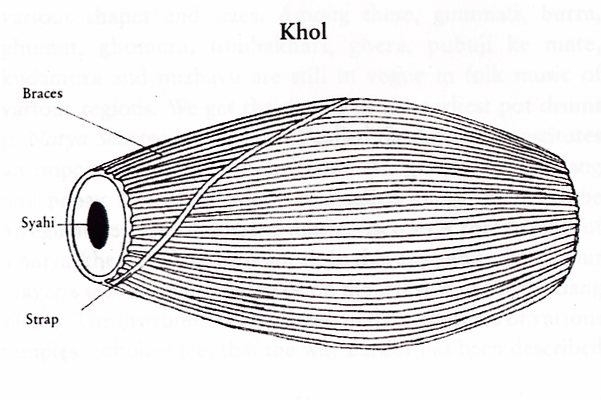Kleines Lexikon indischer Instumente
Der Text ist in gekürzter Form von Suneera Kasliwal, Classical Musical Instruments, Delhi 2001, entnommen.
Khol
The most widely used percussion instrument in eastern India is the khol. It is also called mridang, because it is made of clay, i.e. mrit or mud. The instrument is closely associated with Vaishnavite music of Bengal and Assam.
The khol is a barrel shaped asymmetrical drum. Its two faces are of different sizes, and it seems to resemble the ancient Gopuchha shape of drums, as described by Bharat in his Natya Shastra. The right face of the drum, which is three to five inches in diameter, has a high pitch and produces a metallic sound, whereas the left face, which is six to eight inches in diameter, produces a lower bass sound. The relation between the two faces is almost of an octave, i.e. S-S. The drum is made of a special clay, which is available on the banks of the Ganges in Bengal. The two faces of the drum are covered with two layers of cow leather, one full and the other on the outer periphery of the faces. These parchments are held by braids, both of which are connected with thin leather strips equally distributed into thirty-two spaces. Nowadays, in some khols cotton strips are also used. The entire instrument is painted with a paste of flour mixed with red colour. The syahi or the black permanent mixture, that provides a good tonal quality, is also put on the central portion of the right face of the khol like other percussion instruments, but the preparation of this mixture is quite different from the syahi of the tabia or pakhavaj. The syahi used for khol is prepared from mud and rice dust with a tiny portion of iron fillings. The left face of the drum is loaded with mud and rice dust paste in the centre, and is painted red.
The khol is made of fixed pitches and on-the-spot tuning is not possible. However, by putting a wet cloth on the left face of the drum, the note can be lowered a little.
The khol invariably dangles around the neck of the player with the help of a strap and is played with fingers. The instrument is also very popular in Rabindra Sangeet and almost all the folk music forms of Bengal.
